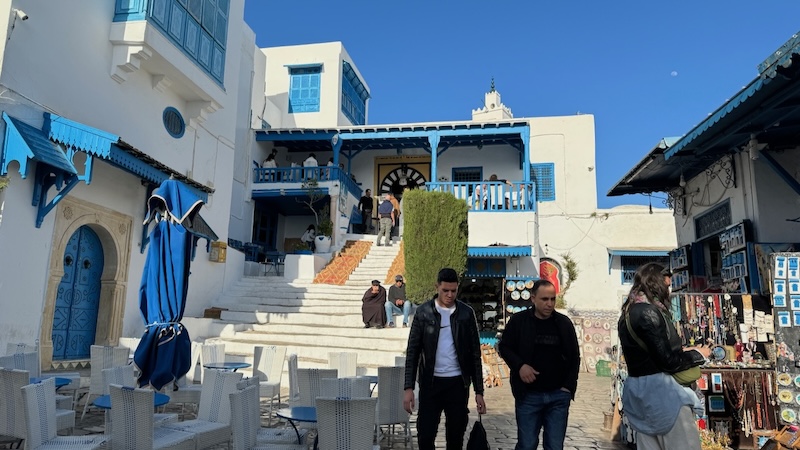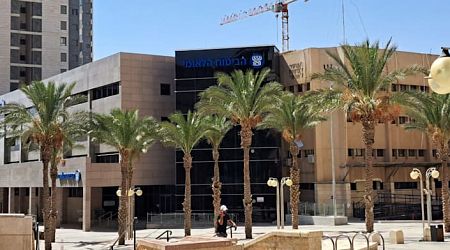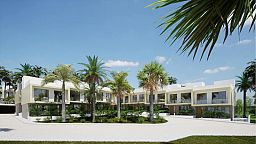Today, Tunis is a bustling metropolis that harmoniously balances the old and the new. The city's heart beats in its medina, a UNESCO World Heritage site, filled with narrow streets and alleyways that echo tales from centuries past.

Walking through the vibrant bazaar, the air is filled with the scents of jasmine and spices. Each corner of the souk bursts with colourful crafts, textiles, and intricate jewellery, inviting passersby to linger and explore. Small coffee shops and restaurants hidden in the labyrinth of the souks narrow streets are full of locals enjoying the moment. Time has chilled down to linger a bit longer with the relaxed city dwellers. The medina, with its historic mosques and bustling markets, offers a glimpse into Tunisian life that has remained largely unchanged over the centuries.
The main artery of Tunis, Avenue Habib Bourguiba, presents a stark contrast with its French colonial architecture and modern shops. The street is alive with cafes and bookshops, inviting travellers and locals alike to enjoy the shade of its leafy trees and the vibrant city life.

The Tunisian Revolution, often referred to as the Jasmine Revolution, ignited a wave of change across the Arab world in late 2010 and early 2011. Sparked by widespread grievances over unemployment, corruption, and political repression, the revolution led to the ousting of President Zine El Abidine Ben Ali after 23 years of rule. This dramatic event was the catalyst for the Arab Spring, inspiring similar movements in other countries. In Tunis, the symbolic heart of the revolution, a clock was added to the Freedom Tower at the end of Avenue Habib Bourguiba to mark the dawn of a new era. This clock stands as a reminder of Tunisia's role in the wider regional upheaval and its hopeful aspirations for democracy and social justice. The tower and its clock have become emblematic of the country’s quest for freedom and the spirit of resilience that continues to shape its national identity.

Historic Carthage and the Cathedral
A short drive from the city center are the ruins of ancient Carthage. Once home to Queen Dido and the legendary lover of Aeneas, the site offers a panoramic view of the azure Mediterranean. Beside these poignant ruins stands the imposing Cathedral of St. Louis, a reminder of Tunisia's colonial past and a beacon of tranquility overlooking the sea.

The Cathedral of St. Louis, perched on the Byrsa Hill in Carthage, stands as a monument to the country's French colonial past. Built in the late 19th century, the cathedral was dedicated to King Louis IX of France, who died in Tunisia during the Eighth Crusade. Its architecture combines Romanesque and Moorish influences, creating a unique blend that reflects the cultural intersections of the region. The building features an impressive façade with intricate decorative elements, while its interior boasts elegant arches and towering ceilings. Although it no longer serves as a place of worship, the Cathedral of St. Louis remains a significant historical site, offering insights into Tunisia's multifaceted heritage.
Sidi Bou Said: A painter’s dream
Further enchanting is Sidi Bou Said, a must-visit cliff-top village inside the city of Tunis with its white buildings and striking blue doors and windows. The cobblestone streets, draped in bougainvillea, and the art galleries create a bohemian ambiance that is both relaxing and inspiring. Come evening, couples walk in the village hand in hand and sit in its tranquil coffeeshops for a drink, tea or a shared Shisha smoke. The picturesque village is probably an Instagramer’s paradise with lots of traditional, but well preserved and renovated buildings, decorated doorways and gates and panoramic view of the Mediterranean sea and the beaches of Tunis. Boutique hotels in the village offer unique traditionally decorated cozy rooms with views of the sea or opening into a tranquil inner courtyard. Prices in the high season could rise up to hundreds of euros per night.

View from Sidi Dou Said over the marina of Tunis
The National Museum of Bardo
The Bardo Museum, located in the same courtyard as the parliament, is partly housed in a former Ottoman palace, reflecting the grandeur and elegance of its original function. This historic structure, known for its lavish interiors, once served as the residence of Tunisian beys during the Ottoman period. The palace's rich decor, with its intricate tile work, opulent ceilings, and spacious courtyards, showcases the luxurious lifestyle of the ruling elite. Over time, this stunning piece of Ottoman heritage was transformed into a museum, now famous for its vast collection of Roman mosaics and artefacts from Tunisia's diverse history. The blend of the building's architectural beauty and its invaluable exhibits makes the Bardo Museum a unique cultural treasure, making the visit a journey through Tunisia’s rich history. The museum houses one of the world’s largest collections of Roman mosaics, breathtaking in their detail and storytelling. Room after room each wall and floor tells the story of how people lived thousands of years ago, and surprisingly the lives and livelihoods still resound with the modern viewer. Mosaics depict farming, fishing, hunting, animals and other scenes of life, with a touch of mythology and fantasy.

Hammamet
After a couple of days in Tunis, we started our road trip towards the south. The first city to stop in was the seaside resort of Hammamet. One of the popular tourist destinations, Hammamet has also attracted numerous celebrities and ordinary foreigners who have acquired properties in the city and live there either permanently or part of the year.

With its sandy beaches and the imposing silhouette of its fortress Hammamet is certainly worth a visit or even a short stay. Hammamet’s history as a favoured destination for artists like Oscar Wilde and Sophia Loren adds a touch of glamour to its tranquil geography.
The fortress of Hammamet, standing guard over the sea, narrates stories of bygone eras when pirates and traders navigated these waters. Today, it offers spectacular views of the coastline and serves as a poignant reminder of the town's strategic importance through the ages.
Kairouan

Kairouan's main walking street
The journey southward brought me to Kairouan, an Islamic cultural hub. Here, a must visit site is the Great Mosque of Kairouan, an architectural masterpiece, also known as the Mosque of Uqba. The biggest mosque in Tunisia is one of the oldest places of worship in the Islamic world and a key pilgrimage site for Muslims and stands as a testament to the city's historical significance in the Islamic world.

Grand mosque of Kairouan
Kairouan, founded in the 7th century, is one of the most ancient and spiritually significant cities in the Islamic world. Established by the Arab general Uqba ibn Nafi in 670 AD as a military base for the conquest of the Maghreb, it quickly evolved into a major center of Islamic culture and learning.
Oasis of Chebika

Venturing deeper into the desert, we reached the oasis of Chebika. This natural haven, once a Roman outpost, is now a lush escape from the arid surroundings, where palm trees frame crystal-clear springs. The original ancient town of Chebika on the hills beside the springs is now stands in ruins and is populated with salesmen of stones and crystals, which locals collect from the surrounding mountains. A walk to the top of the hill is worth the view.
Festival in Tamerza

The highlight in Tamerza was the Festival du tourisme de montagne, an event celebrating local culture and the breathtaking landscapes. Arranged once a year, the festival is the local populations welcome to tourists and travellers. Tunisian kindness and hospitality can be sensed in the air, when young and old of the village dance and sing, while walking down the main street of the village over the bridge and down by the riverbed.
The nearby canyon with its rugged, untouched beauty provides a shadow and quite, for a moment of chill, or a day-trip activity for those willing to take the challenge of the 15 km hike.

Local youth enjoying a picnic in the shadows of the canyon
In Tozeur, we indulged in a culinary extravaganza, featuring local dishes that tantalize the palate with flavors of dates and spices. Tisouros with its specialty "Lamb a la gargoulette" was certainly an experince to remember.

The Museum of Dates offeres insights into the significance of palm trees in the region, which shape both the cuisine and culture. The tranquil garden also includes many other interesting and exotic trees and vegetations with the possibility of a outdoor lunch.

Visitors are greeted with mint tea in the garden of the Date Museom
Star Wars and Beyond

Star Wars location near Douz
The town of Douz, often referred to as the gateway to the Sahara, has a unique claim to fame as one of the filming locations for the iconic Star Wars saga (1999). George Lucas chose this picturesque desert landscape as a stand-in for the planet Tatooine, home of Anakin and Luke Skywalker. The stark, arid dunes and vast, open skies provided the perfect backdrop for the alien world, bringing the fantasy of distant galaxies to life. This connection has turned Douz into a pilgrimage site for Star Wars fans, eager to tread the sands that once hosted epic adventures of the beloved film series. The region's natural beauty, combined with its cinematic legacy, continues to captivate and draw tourists from around the globe.
 The sun setting overt the salt lakes of the Degueche desert
The sun setting overt the salt lakes of the Degueche desert
The mesmerising desert landscapes near Douz served as a pivotal backdrop for the critically acclaimed film "The English Patient” already in 1996. This sweeping World War II drama utilised the stark and beautiful expanses of the Tunisian desert to represent the North African setting of its poignant story. The harsh, yet stunning desert terrain added a layer of dramatic intensity and visual depth to the film, helping it to convey the isolation and emotional turmoil of its characters. This choice of location significantly contributed to the film’s atmosphere, earning it widespread acclaim and several Academy Awards, including Best Picture.

Luxary villa in The Residence Douz Hotel
The Residence Douz Hotel provides a luxurious rest in the heart of the desert. The newly built hotel which is still in the pre-opening stage and will officially launch in October this year, is an extraordinary project which has taken 10 years to build. The hotel which consists of independent villas only, also offers a full fledged spa with Turkish bath, pools and treatments. Built right at the gate of the desert it offers a surreal experience: when inside you are pampered by utmost comfort and luxury, walking out the door the embrace of the sandy desert breeze invites you to an adventure as attractive as the comfort inside.
Matmata’s Berber Heritage
Matmata offered an intriguing look at Berber life with its underground dwellings, some of which have been transformed into unique lodgings like the Hotel Sidi Driss, another site immortalised by Star Wars.

Second Star Wars location in Matmata now serves as a hotel
Berber architecture is a distinctive and practical style adapted to the harsh environments characterised by its use of locally sourced materials, such as earth and stone, which provide excellent insulation against both the searing heat of summer and the cold of winter. Structures often include thick walls, flat roofs, and are typically designed with a central courtyard or a cluster layout to maximise shade and communal activity spaces. In regions like Matmata in Tunisia, Berber houses are underground troglodyte structures, which are dug into the ground, or walls of hills to create cave-like homes that maintain a constant and comfortable temperature year-round. Some hotels in the area use this style for all of their rooms, which means there are no windows to the other side. This style probably was an inspiration for Lucas, making him choose Tunisia and Matmata as a filming site.
Island Retreat to Djerba
The ferry to Djerba opened the door to an island famed for its thalassotherapy resorts and the serene beauty of its landscapes.

Potter Aiman Kadhi continues the family tradition of hand made ceramics in Djerba
Djerba, often hailed as the island of dreams, lies off the southeastern coast of Tunisia in the Gulf of Gabès. Known for its flat, arid landscape interspersed with olive groves and palm trees, the island is the largest in North Africa, covering an area of about 514 square kilometres. This makes it almost twice larger than the island country of Malta, which spans around 316 square kilometres. Historically, Djerba holds a rich tapestry of cultural influences, having been occupied by various civilisations including the Romans, Vandals, Byzantines, Arabs, and the French. This mosaic of histories is reflected in the diverse architecture, languages, and traditions that colour the island. Renowned for its beautiful beaches and distinct, whitewashed towns, Djerba's unique charm and strategic location have made it a pivotal point of commerce and cultural exchange throughout the centuries. Djerba is also the home of a large Jewish minority, with its own historic Synagogue. Djerba was officially designated a UNESCO World Heritage Site in 2023.

A must visit in Djerba is the Musee de Guellala, which details the rich heritage of Djerba's pottery, lifestyle and architecture. Other must-see attractions of Djerba are the crocodile farm and it’s side museum and the Art Street, where local art students have painted amazing murals on the walls of the houses and businesses in a quarter of the city. Art is intertwined with the lifestyle of Djerbans with several ceramic workshops producing everything from small decorations to huge jars used traditionally for preservation and storage of food and water. Djerba has abundant clay mines traditionally owned by families and inherited by next generations, thus preserving the art of ceramics in the families.

Street art in Djerba
A Mecca of Thalassotherapy
Renowned for its thalassotherapy, second only to France, Tunisia attracts visitors seeking wellness and rejuvenation.

The indoor pool of Hotel Odyssee Resort Thalasso & Spa in Zarzis
Thalassotherapy, derived from the Greek word 'thalassa' meaning sea, is a form of therapy that harnesses the healing properties of seawater and marine products. This treatment method is based on the belief that immersion in warm seawater, marine mud, algae, and proteins helps rejuvenate and restore health. Rich in minerals and elements like magnesium, potassium, and iodide, these natural resources are believed to improve circulation, relieve pain, and promote skin health. Popular in coastal regions, thalassotherapy is particularly renowned in Tunisia, where its gentle climate and pristine Mediterranean waters make it a favoured destination for those seeking wellness and relaxation. The country's state-of-the-art facilities combine traditional methods with modern spa treatments, attracting visitors from around the world, especially from Europe, who are drawn to its therapeutic benefits and tranquil settings.
 Scrubbing is a popular treatment before massage in Ulysse resort
Scrubbing is a popular treatment before massage in Ulysse resort
Djerba, with its state-of-the-art facilities like Ulysse Djerba Thalasso & Spa epitomises this tradition. Established already in the 1960s, Ulysse has hosted world leaders, celebrities and iconic stars of French cinema like Jean Paul Belmondo and Allain Delone.
Djerba can be reached by ferry, but it also has a land bridge which conjugates to the town of Zarzis. There another Thalasso center, Hotel Odyssee Resort Thalasso & Spa is hidden gem of architecture and seaside resort with a very attractive price/quality ratio.
Journey Back to Tunis
The return to Tunis marked the end of a 2400 km journey—a voyage through time, culture, and the stunning landscapes of Tunisia. Each mile brought new discoveries and a deeper appreciation for this land of contrasts, where history and modernity exist side by side in harmony.
Tunisia indeed is a country worth visiting and revisiting. All through the journey, even in the most remote areas, I felt safe and welcomed. Tunisian hospitality is one of a kind and the climate is mild. Travelling through the country one can appriciate the drastic change in the scenery, and the contrast between the green land of the north with lots of olive trees, and the arid desert of the south. The high season is during the summer months, but for visitors from northern Europe or Scandinavia I would recommend visiting late spring or early autumn. I would definitely go again.
Text and photos
Alexis Kouros
Helsinki Times































